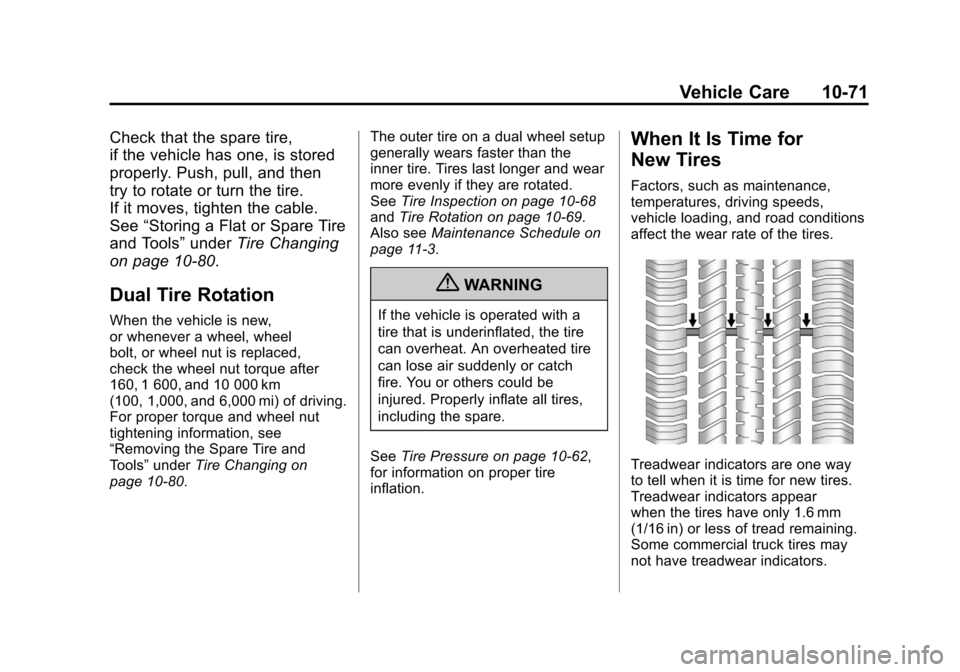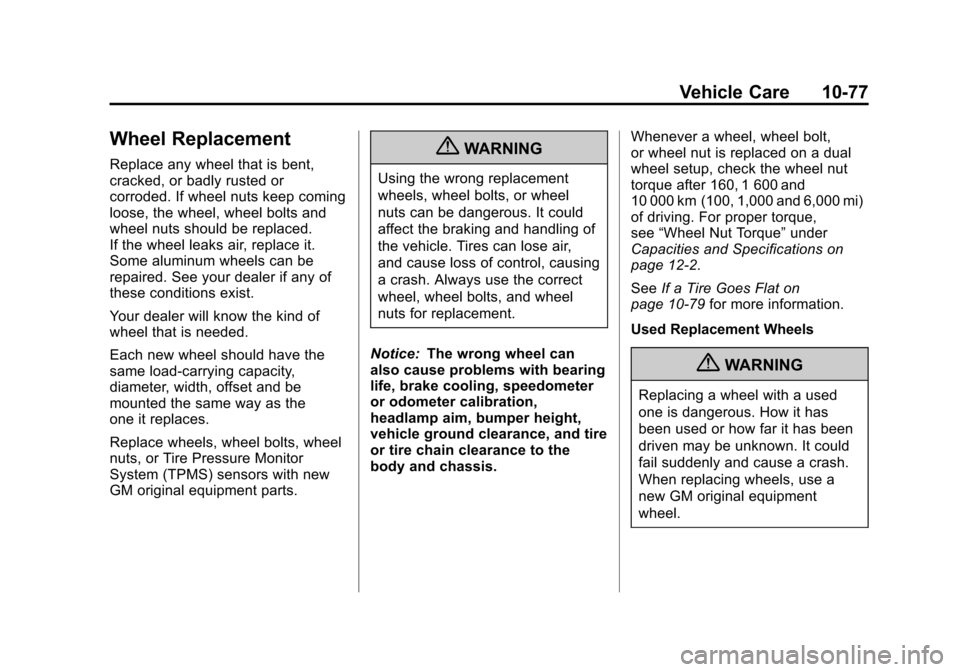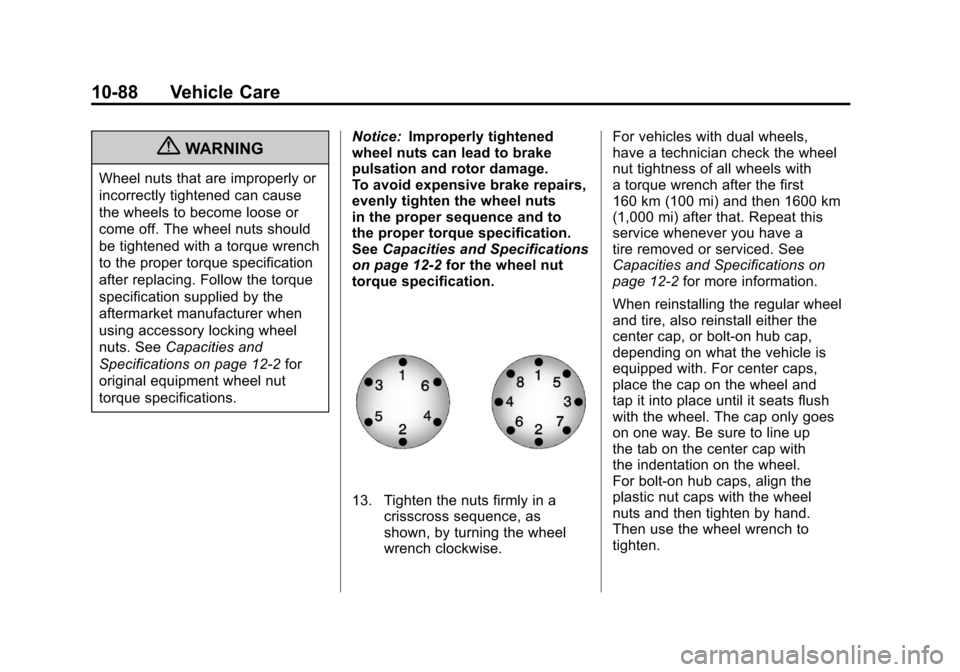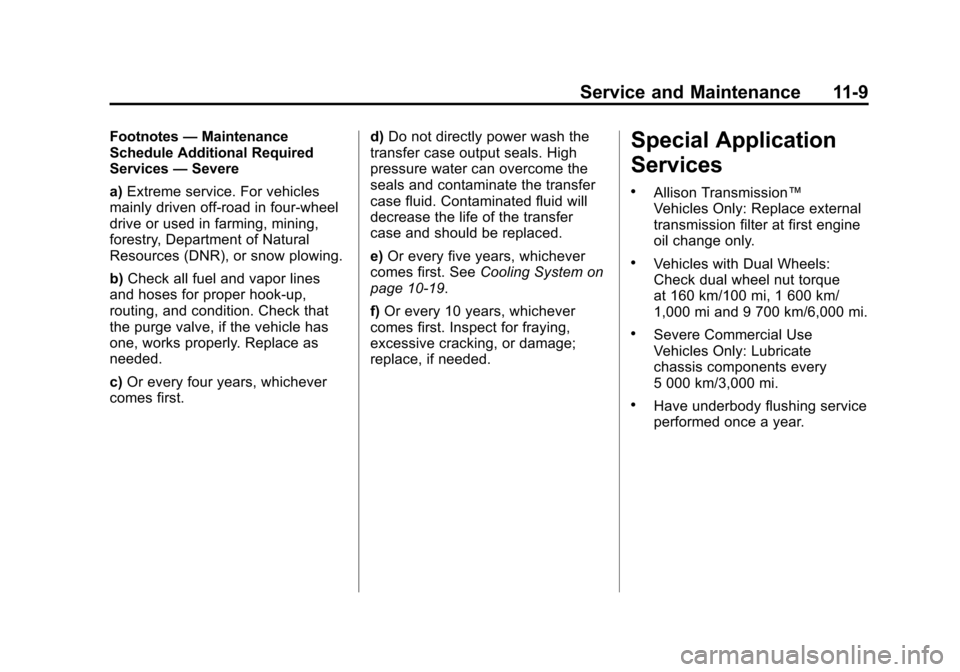Page 477 of 584

Black plate (71,1)Chevrolet Silverado Owner Manual - 2012
Vehicle Care 10-71
Check that the spare tire,
if the vehicle has one, is stored
properly. Push, pull, and then
try to rotate or turn the tire.
If it moves, tighten the cable.
See“Storing a Flat or Spare Tire
and Tools” underTire Changing
on page 10‑80.
Dual Tire Rotation
When the vehicle is new,
or whenever a wheel, wheel
bolt, or wheel nut is replaced,
check the wheel nut torque after
160, 1 600, and 10 000 km
(100, 1,000, and 6,000 mi) of driving.
For proper torque and wheel nut
tightening information, see
“Removing the Spare Tire and
Tools” underTire Changing on
page 10‑80. The outer tire on a dual wheel setup
generally wears faster than the
inner tire. Tires last longer and wear
more evenly if they are rotated.
See
Tire Inspection on page 10‑68
and Tire Rotation on page 10‑69.
Also see Maintenance Schedule on
page 11‑3.
{WARNING
If the vehicle is operated with a
tire that is underinflated, the tire
can overheat. An overheated tire
can lose air suddenly or catch
fire. You or others could be
injured. Properly inflate all tires,
including the spare.
See Tire Pressure on page 10‑62,
for information on proper tire
inflation.
When It Is Time for
New Tires
Factors, such as maintenance,
temperatures, driving speeds,
vehicle loading, and road conditions
affect the wear rate of the tires.
Treadwear indicators are one way
to tell when it is time for new tires.
Treadwear indicators appear
when the tires have only 1.6 mm
(1/16 in) or less of tread remaining.
Some commercial truck tires may
not have treadwear indicators.
Page 483 of 584

Black plate (77,1)Chevrolet Silverado Owner Manual - 2012
Vehicle Care 10-77
Wheel Replacement
Replace any wheel that is bent,
cracked, or badly rusted or
corroded. If wheel nuts keep coming
loose, the wheel, wheel bolts and
wheel nuts should be replaced.
If the wheel leaks air, replace it.
Some aluminum wheels can be
repaired. See your dealer if any of
these conditions exist.
Your dealer will know the kind of
wheel that is needed.
Each new wheel should have the
same load-carrying capacity,
diameter, width, offset and be
mounted the same way as the
one it replaces.
Replace wheels, wheel bolts, wheel
nuts, or Tire Pressure Monitor
System (TPMS) sensors with new
GM original equipment parts.{WARNING
Using the wrong replacement
wheels, wheel bolts, or wheel
nuts can be dangerous. It could
affect the braking and handling of
the vehicle. Tires can lose air,
and cause loss of control, causing
a crash. Always use the correct
wheel, wheel bolts, and wheel
nuts for replacement.
Notice: The wrong wheel can
also cause problems with bearing
life, brake cooling, speedometer
or odometer calibration,
headlamp aim, bumper height,
vehicle ground clearance, and tire
or tire chain clearance to the
body and chassis. Whenever a wheel, wheel bolt,
or wheel nut is replaced on a dual
wheel setup, check the wheel nut
torque after 160, 1 600 and
10 000 km (100, 1,000 and 6,000 mi)
of driving. For proper torque,
see
“Wheel Nut Torque” under
Capacities and Specifications on
page 12‑2.
See If a Tire Goes Flat on
page 10‑79 for more information.
Used Replacement Wheels
{WARNING
Replacing a wheel with a used
one is dangerous. How it has
been used or how far it has been
driven may be unknown. It could
fail suddenly and cause a crash.
When replacing wheels, use a
new GM original equipment
wheel.
Page 494 of 584

Black plate (88,1)Chevrolet Silverado Owner Manual - 2012
10-88 Vehicle Care
{WARNING
Wheel nuts that are improperly or
incorrectly tightened can cause
the wheels to become loose or
come off. The wheel nuts should
be tightened with a torque wrench
to the proper torque specification
after replacing. Follow the torque
specification supplied by the
aftermarket manufacturer when
using accessory locking wheel
nuts. SeeCapacities and
Specifications on page 12‑2 for
original equipment wheel nut
torque specifications. Notice:
Improperly tightened
wheel nuts can lead to brake
pulsation and rotor damage.
To avoid expensive brake repairs,
evenly tighten the wheel nuts
in the proper sequence and to
the proper torque specification.
See Capacities and Specifications
on page 12‑2 for the wheel nut
torque specification.
13. Tighten the nuts firmly in a crisscross sequence, as
shown, by turning the wheel
wrench clockwise. For vehicles with dual wheels,
have a technician check the wheel
nut tightness of all wheels with
a torque wrench after the first
160 km (100 mi) and then 1600 km
(1,000 mi) after that. Repeat this
service whenever you have a
tire removed or serviced. See
Capacities and Specifications on
page 12‑2
for more information.
When reinstalling the regular wheel
and tire, also reinstall either the
center cap, or bolt-on hub cap,
depending on what the vehicle is
equipped with. For center caps,
place the cap on the wheel and
tap it into place until it seats flush
with the wheel. The cap only goes
on one way. Be sure to line up
the tab on the center cap with
the indentation on the wheel.
For bolt-on hub caps, align the
plastic nut caps with the wheel
nuts and then tighten by hand.
Then use the wheel wrench to
tighten.
Page 523 of 584

Black plate (9,1)Chevrolet Silverado Owner Manual - 2012
Service and Maintenance 11-9
Footnotes—Maintenance
Schedule Additional Required
Services —Severe
a) Extreme service. For vehicles
mainly driven off‐road in four‐wheel
drive or used in farming, mining,
forestry, Department of Natural
Resources (DNR), or snow plowing.
b) Check all fuel and vapor lines
and hoses for proper hook‐up,
routing, and condition. Check that
the purge valve, if the vehicle has
one, works properly. Replace as
needed.
c) Or every four years, whichever
comes first. d)
Do not directly power wash the
transfer case output seals. High
pressure water can overcome the
seals and contaminate the transfer
case fluid. Contaminated fluid will
decrease the life of the transfer
case and should be replaced.
e) Or every five years, whichever
comes first. See Cooling System on
page 10‑19.
f) Or every 10 years, whichever
comes first. Inspect for fraying,
excessive cracking, or damage;
replace, if needed.Special Application
Services
.Allison Transmission™
Vehicles Only: Replace external
transmission filter at first engine
oil change only.
.Vehicles with Dual Wheels:
Check dual wheel nut torque
at 160 km/100 mi, 1 600 km/
1,000 mi and 9 700 km/6,000 mi.
.Severe Commercial Use
Vehicles Only: Lubricate
chassis components every
5 000 km/3,000 mi.
.Have underbody flushing service
performed once a year.
Page 538 of 584
Black plate (4,1)Chevrolet Silverado Owner Manual - 2012
12-4 Technical Data
ApplicationCapacities
Metric English
Transmission Fluid - Automatic (Pan Removal and Filter Replacement)
4-Speed Transmission 4L60-E Electronic Transmission 4.7 L 5.0 qt
6-Speed Transmission 6L80-E 5.7 L 6.0 qt
6-Speed Transmission 6L90-E 6.0 L 6.3 qt
6-Speed Transmission Allison 7.0 L 7.4 qt
Transmission Fluid - Manual (Drain and Refill) 1500 Series 4.4 L 4.6 qt
3500 Series 3.5 L 3.7 qt
Wheel Nut Torque 190 Y140 ft lb
All capacities are approximate. When adding, be sure to fill to the approximate level, as recommended in this
manual. Recheck fluid level after filling.